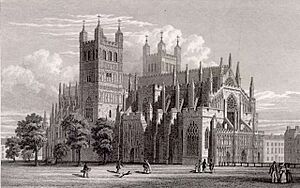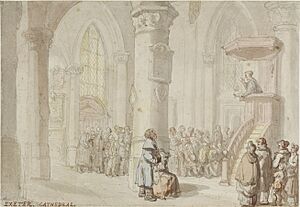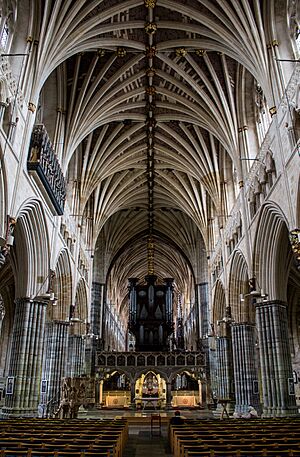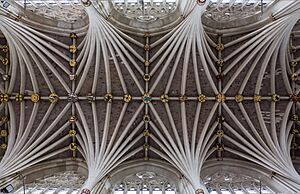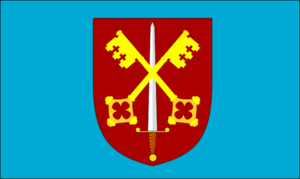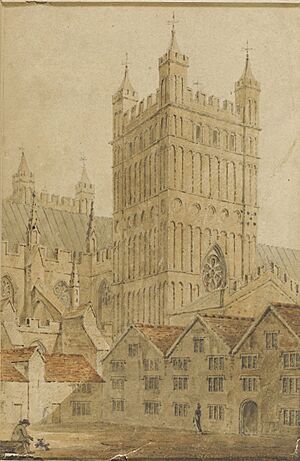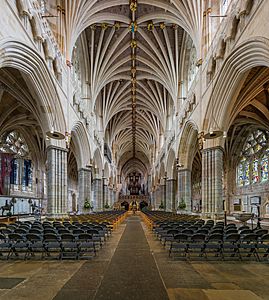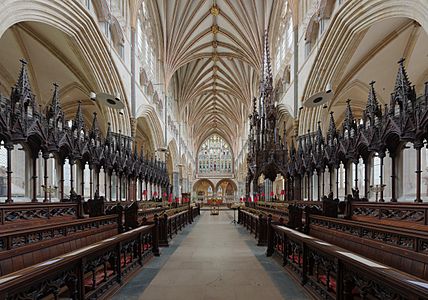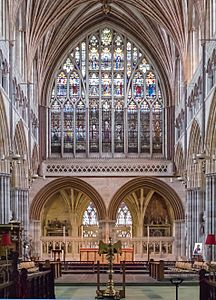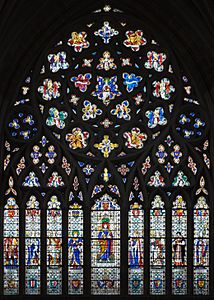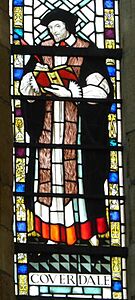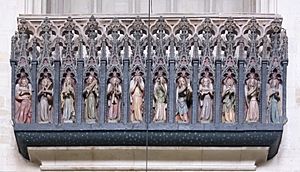Exeter Cathedral facts for kids
Quick facts for kids Exeter Cathedral |
|
|---|---|
| Cathedral Church of Saint Peter in Exeter | |
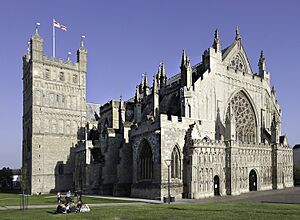 |
|
| 50°43′21″N 03°31′47″W / 50.72250°N 3.52972°W | |
| Location | Exeter, Devon |
| Country | England |
| Denomination | Church of England |
| Previous denomination | Roman Catholic |
| Tradition | Anglo-Catholic |
| Architecture | |
| Functional status | Active |
| Previous cathedrals | 2 |
| Style | Norman, Gothic |
| Years built | 1112–1400 |
| Specifications | |
| Length | 383 feet (117 m) |
| Bells | 15 (12 + 2 + Bourdon) |
| Tenor bell weight | 3,684 kilograms (8,122 lb) |
| Administration | |
| Diocese | Exeter (since 1050) |
| Province | Canterbury |
Exeter Cathedral, also known as the Cathedral Church of Saint Peter in Exeter, is a large church in Exeter, Devon, England. It is the main church for the Bishop of Exeter and belongs to the Church of England. The building was mostly finished by the year 1400. It is famous for its old misericords (small wooden seats), an astronomical clock, and the world's longest medieval stone vaulted ceiling without interruption.
Contents
History of Exeter Cathedral
The land where Exeter Cathedral stands today was once home to Roman buildings. A Roman army fort was built there between 50 and 75 AD. In 1971, a Roman bathhouse was found.
The first cathedral in Exeter was started in 1050. It was dedicated to Saint Peter. The bishop's main church was moved to Exeter from Crediton because people were worried about attacks from the sea. An older Saxon church, dedicated to Saint Mary and Saint Peter, was used by the first bishop, Leofric.
In 1107, William Warelwast became bishop. He decided to build a new, larger cathedral in the Norman style. Building officially began in 1133, but it took many years to complete.
By 1258, the Norman cathedral was considered old-fashioned. Bishop Walter Branscombe decided to rebuild it in the Gothic style, similar to Salisbury Cathedral. However, many parts of the Norman building were kept. This included the two large square towers and some of the original walls. The new cathedral was built using local stone, including Purbeck Marble. Most of the new cathedral was finished by 1400.
Like many English cathedrals, Exeter Cathedral faced challenges during the Dissolution of the Monasteries. It also suffered damage during the English Civil War, when its cloisters (covered walkways) were destroyed. After King Charles II returned to power, a new pipe organ was built.
During World War II, Exeter was bombed by German planes. On May 4, 1942, a bomb hit the cathedral directly. It destroyed the chapel of St James and damaged other parts. Luckily, many important items like old glass, the misericords, and precious documents had been moved to safety. The damaged parts were later repaired and restored.
In July 2023, the cathedral agreed to share its Lady Chapel with Mint Methodist Exeter.
Cathedral Architecture
The Norman cathedral began construction in 1112. It was officially opened in 1133. By this time, the choir, transept, and the first two sections of the nave were likely complete. You can still see parts of the Norman building in the large transept towers. By 1160, the nave and west front were finished. A cloister and chapter house were added between 1180 and 1244.
In the 1270s, work began to replace the entire east end of the cathedral. This included the chapels at the east end. The retrochoir, presbytery, and choir were built in the 1290s. The original choir had two levels, but it was later changed to three.
By 1328, the church was mostly complete up to the first two sections of the nave. You can see a change in the vaults here. The west front, which is the main entrance, is in the same place as the old Norman one. This is why the nave sections get narrower towards the west.
The beautiful screen with statues on the west front was likely designed by William Joy. He became the master builder in 1342. The cathedral's architecture looks very balanced. It has a continuous run of tierceron vaults from west to east. These vaults create a stunning ceiling.
Special Features Inside
The cathedral has many interesting features inside. These include the misericords, the minstrels' gallery, an astronomical clock, and a large organ. The multi-ribbed ceiling and the strong pillars in the nave are also notable.
The bishop's throne in the choir is 18-metre-high (59 ft). It was made from Devon oak wood between 1312 and 1316. The choir stalls nearby were made later in the 1870s. The Great East Window has a lot of original 14th-century glass. There are also over 400 ceiling bosses. These are carved decorations where the ribs of the vaulted ceiling meet. One boss shows the murder of Thomas Becket.
Because Exeter Cathedral does not have a central tower, it has the longest uninterrupted medieval vaulted ceiling in the world. It stretches for about 96 m (315 ft).
Misericords
The fifty misericords in Exeter Cathedral are the oldest complete set in the United Kingdom. They were carved between 1220 and 1260. Among the carvings, you can see the earliest known wooden picture of an elephant in the UK.
Minstrels' Gallery
The minstrels' gallery is in the nave and dates back to around 1360. It is special because it is unique among English cathedrals. The front of the gallery has 12 carved and painted angels. These angels are playing medieval musical instruments. Some of the instruments include a gittern, bagpipe, shawm, vielle, harp, jew's harp, trumpet, organ, citole, recorder, tambourine, and cymbals.
Astronomical Clock
The Exeter Cathedral Astronomical Clock is one of several famous old astronomical clocks in western England. Others can be found at Wells and Ottery St Mary.
The main, lower, dial is the oldest part, from 1484. A hand with a fleur-de-lys shows the hour on a 24-hour dial. A silver ball and inner dial show the age and phase of the moon. The upper dial, added in 1760, shows the minutes.
The Latin phrase Pereunt et imputantur is written on the clock. It means "they perish and are reckoned to our account." This refers to how we spend our hours. The original clock mechanism is on the floor below. A small hole near the bottom of the door below the clock was cut in the 1600s. This was so the bishop's cat could get in to catch mice that were attracted to the clock's grease.
Library
The cathedral's library started with Bishop Leofric (1050–1072). He gave the cathedral 66 books. Only one of these, the Exeter Book of Anglo-Saxon poetry, is still in the library today. In 1327, an inventory listed 230 book titles.
In 1412–13, a new reading area was set up for the books. Some books were repaired and even chained to desks to keep them safe. A 1506 catalogue showed the library had over 530 titles.
In 1602, 81 manuscripts were given to Thomas Bodley for the Bodleian Library at Oxford. During the 1650s, some cathedral buildings were taken away. Many books were saved by Dr. Robert Vilvaine, who moved them to St John's Hospital. Later, he helped fund the conversion of the Lady chapel into a new library, and the books were brought back.
By 1752, the collection had grown to about 5,000 books. In 1820, the library moved to the chapter house. Later, in the 19th century, two large collections were added. A new building was needed to hold all the books. This new building was designed by John Loughborough Pearson. Today, the library has a good collection of early medical books.
Bells
Both of the cathedral's towers have bells. The North Tower holds a very large bell called Peter. It weighs about 80-hundredweight (4.1-tonne). Peter used to swing, but now it is only chimed.
The South Tower has the second heaviest set of 12 bells in the world that can be rung for change ringing. Only Liverpool Cathedral has heavier bells. There are also two extra bells that play semitones.
Music at the Cathedral
Choir
The Exeter Cathedral Choir has 38 Choristers (boys and girls). It also includes Choral Scholars and Lay Vicars. There is also a volunteer choir called the St Peter's Singers, which started in 1881.
Organ
The cathedral organ stands on a beautiful medieval screen. This screen separates the quire (where the choir sits) from the nave (the main part of the church). The first organ was built in 1665. It was rebuilt in 1891 and again in 1931. The largest pipes are very tall and are located inside the south transept. The organ has a special "trompette militaire" stop, which is rare.
In January 2013, the organ began a big refurbishment. This work was finished in October 2014. The organ was put back together, and its sound was carefully tuned.
Wildlife
The tube web spider Segestria florentina lives in the outer walls of the cathedral. This spider is known for its shiny green fangs. The walls are made of stone that can decay, creating cracks where these spiders and other small creatures live.
Images for kids
-
Rubbing from a monumental brass of Sir Peter Courtenay
-
Prest's wife and the Stonemason from an 1887 edition of Foxe's Book of Martyrs
See also
 In Spanish: Catedral de Exeter para niños
In Spanish: Catedral de Exeter para niños



